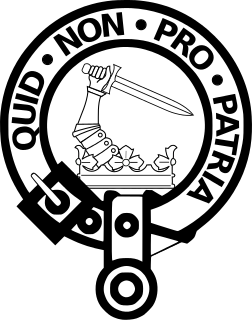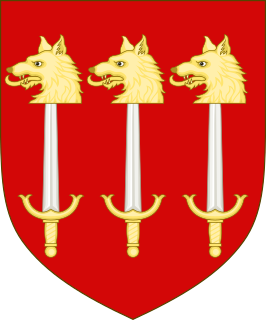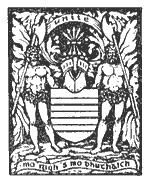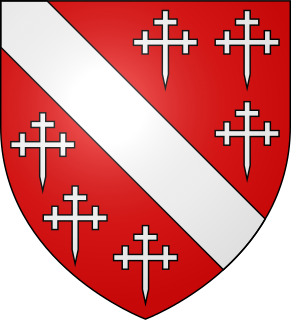
Clan Donnachaidh, also known as Clan Robertson, or Duncan is a Scottish clan.

Clan Mackintosh is a Scottish clan from Inverness in the Scottish Highlands. The chiefs of the clan are the Mackintoshes of Mackintosh. Another branch of the clan, the Mackintoshes of Torcastle, are the chiefs of Clan Chattan, a historic confederation of clans.

The Clan Macrae is a Highland Scottish clan. The clan has no chief; it is therefore considered an armigerous clan.

Clan MacDonnell of Glengarry is a Scottish clan and is a branch of the larger Clan Donald. The clan takes its name from Glen Garry where the river Garry runs eastwards through Loch Garry to join the Great Glen about 16 miles (25 km) north of Fort William, Highland.

Clan Gunn is a Highland Scottish clan associated with lands in northeastern Scotland, including Caithness, Sutherland and, arguably, the Orkney Isles. Clan Gunn is one of the oldest Scottish Clans, being descended from the Norse Jarls of Orkney and the Pictish Mormaers of Caithness.

Clan Macnaghten is a Scottish clan.

Clan Sutherland is a Highland Scottish clan whose traditional territory is the shire of Sutherland in the far north of Scotland. The chief of the clan was also the powerful Earl of Sutherland, however in the early 16th century this title passed through marriage to a younger son of the chief of Clan Gordon. The current chief is Alistair Sutherland who holds the title Earl of Sutherland.

Clan Cameron is a West Highland Scottish clan, with one main branch Lochiel, and numerous cadet branches. The Clan Cameron lands are in Lochaber and within their lands lies Ben Nevis which is the highest mountain in the British Isles. The Chief of the clan is Laird of Lochiel but customarily referred to as simply "Lochiel".

Clan Dewar is a Scottish clan.

Clan MacAlister is a Scottish Clan. The clan is the earliest branch to have split off from Clan Donald, claiming descent from Alasdair Mòr, son of Domhnall founder of Clan Donald. From Alasdair Mòr the clans takes its surname MacAlister; this surname is an Anglicisation of the Gaelic MacAlasdair meaning "son of Alasdair". In the 15th century the chief of the clan was seated in Kintyre, and the clan was centred there until the 18th century, when a chief sold the family estate in preference to an estate in the Scottish Lowlands.

Clan Skene is a Scottish clan.
Taylor is a sept ("branch") of Clan Cameron, a Scottish clan. Present day members of the Taylor sept hold the Scottish surname Taylor.

Clan Matheson is a Highland Scottish clan.

Clan Wood is a Lowland Scottish clan from North Esk, Largo Bay and Angus in Scotland.
The Battle of Torran Dubh also known as the Battle of Torran-dow or the Battle of Torran Du was a Scottish clan battle that was fought in 1517 in Sutherland, in the Scottish Highlands.

Donald Cameron lived in the Scottish Highlands during the reign of Mary, Queen of Scots. Born illegitimate, his father was Ewen Cameron of Lochiel, 14th chief of Clan Cameron, and his mother was the daughter of the chief of Clan MacDougall. Donald Cameron is claimed as the eponymous ancestor of the Taylor sept of Clan Cameron. He is alluded to in the coat of arms of the chief of Clan Cameron, as a likeness of him appears as the supporters holding a Lochaber axe.

Clan Bissett is a Scottish clan. The clan is recognised by the Lord Lyon King of Arms but does not have a clan chief recognised by the Lord Lyon King of Arms, therefore the clan has no standing under Scots Law. Clan Bissett is considered an armigerous clan, meaning that it is considered to have had at one time a chief who possessed the chiefly arms; however, no one at present is in possession of such arms. The surname Bissett is also considered a sept of the Clan Fraser of Lovat.

Clan Gardyne is a lowland Scottish clan from Angus. The clan does currently have a chief, Samuel Edward Britton Gardyne recognised by the Court of the Lord Lyon, therefore it is considered an clan. With the clan spreading as far as New Zealand. Were the current chief lives.

Clan Young is a Scottish clan. The clan does not currently have a clan chief and therefore it is considered an armigerous clan.

Clan Cheyne is a Scottish clan. The clan is officially recognized by the Lord Lyon King of Arms, however as the clan does not currently have a chief recognized by the Court of the Lord Lyon, it is therefore considered an Armigerous clan. The surname Cheyne is also recognized as a sept of the Clan Sutherland, and is accepted as such by the Clan Sutherland Society in Scotland.




















